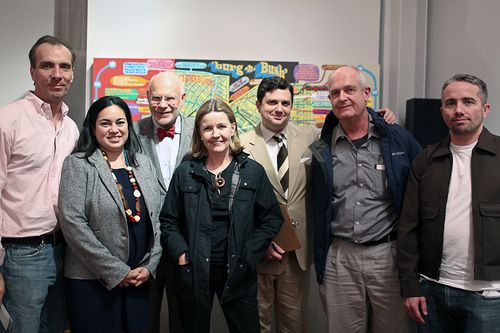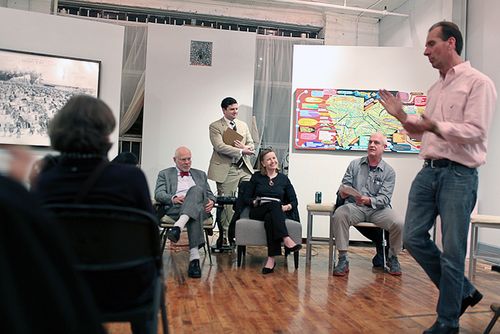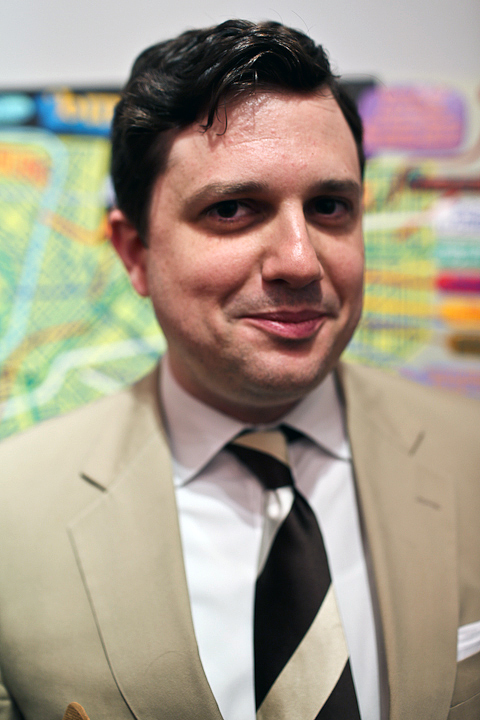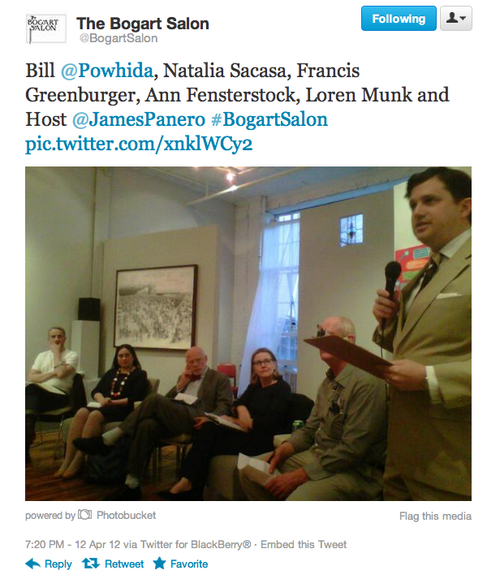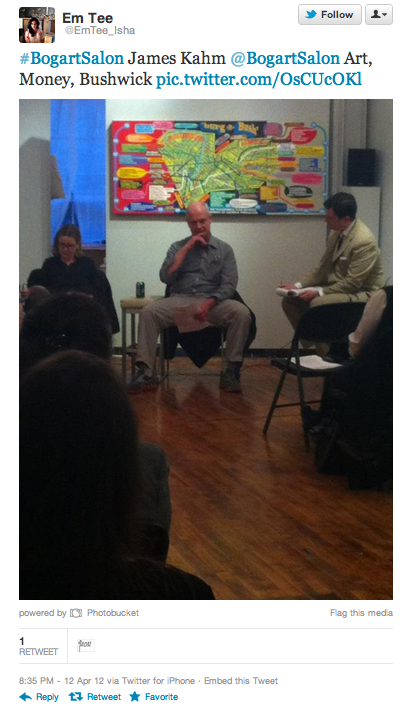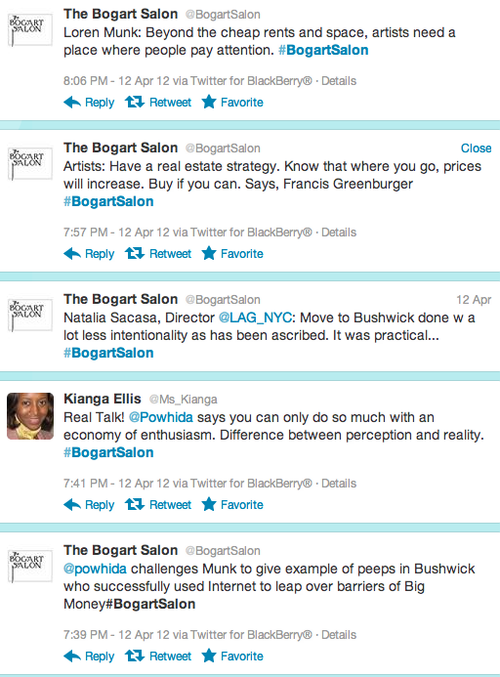The panelists from "Capital and Its Discontents: Art, Money, Real Estate and the Changing Face of Bushwick": Peter Hopkins (Bogart Salon), Natalia Sacasa, Francis Greenburger, Ann Fensterstock, James Panero (host), Loren Munk, and William Powhida. "Burg n Bush," work in progress by Loren Munk, in background. Photograph by famous Bushwick documentarian Meryl Meisler
UPDATE: THE FULL DISCUSSION IS NOW ONLINE HERE
James writes:
On Thursday, April 12, I hosted a panel discussion at The Bogart Salon called "Capital and its Discontents: Art, Money, Real Estate and the Changing Face of Bushwick." You can read all about the run up here.
My panelists were Ann Fensterstock (collector, arts patron, historian), Francis Greenburger (collector, founder of Time Equities), Loren Munk (artist), William Powhida (artist), and Natalia Sacasa (Senior Director, Luhring Augustine).
Art, money, and real estate. These three forces are changing the face of Bushwick. We may not agree on how it’s changing, but we can all agree that the neighborhood of Bushwick is changing quickly. By last count, there were over 35 galleries in Bushwick, up from just a handful a few years ago. Until recently, 56 Bogart, the venue for the panel, was mainly used for light manufacturing. Now it’s filled with new galleries and non-profits--some new, others well established and coming in from elsewhere. And in February, Luhring Augustine, one of the bluest of Chelsea’s blue-chip galleries, opened a 10,000-square-foot outpost in the heart of Bushwick, to the fascination and consternation of the neighborhood’s arts community.
As I said in the panel’s introduction:
If we are here to put capitalism on trial, and capitalism loses, I wouldn’t question capitalism. I would question our judgment.
Yet art, money, and real estate have always had a complex relationship, and lately it seems to be getting more complicated.
According to the New York Times, a chief executive at UBS wealth management informs us that “art is becoming more and more of an asset class.”
Money has always been a component of art, but now it seems to have become art’s defining characteristic. Bill Powhida, in your own work, you ridicule the business side of art, calling the dominance of money “asset classicism”--a term that may speak to our age better than any other.
Up to this point, one thing that has struck me about Bushwick is that the neighborhood seems to exist outside of the arts industrial complex you lampoon. Bushwick has developed something of a micro-economy of its own, with artists bartering with each other and tiny galleries selling work in the hundreds, rather than the tens of thousands, of dollars.
As Bushwick begins to attract a wider pool of collectors, is it a good thing, or is “asset classicism” not far behind?
Following up from "Capital," Kianga Ellis and Trent Morse are hosting "War Room" at the Bogart Salon through Sunday, April 15. Keep up with the discussion here.
Real-time Twitter feed from Bogart
"Capital and its Discontents" on Artinfo.com
Peter Hopkins of Bogart Salon introduces the panel. Showing: Francis Greenburger, James Panero, Ann Fensterstock, and Loren Munk. Off camera: William Powhida and Natalia Sacasa
Here is some press from the first Bogart Salon panel where Hrag Vartanian headed up a great discussion with Deborah Brown, Thomas Burr Dodd, Carolina A. Miranda, and Marco Antonini:
- With Blue Clip Gallery Luhring Augustine Coming Soon, The Scrappy Bushwick Arts Scene Contemplates Its Future ( Rozalia Jovanovic: Capital)
- Bushwick Confronts Itself in Panel on Art Scene's Future (Benjamin Sutton: The L Magazine)
- Bushwick: It’s past, present and future (Jason Andrew: Norte Maar)
- Reports from Last Night's Bushwick Panel (Hrag Vartanian: Hyperallergic)
- Panel on the Bushwick Art Scene (Charles Kessler: Left Wing Art Blog)
- How Was Confronting Bushwick? (Katarina Hybenova and Terri Ciccone: Bushwick Daily)
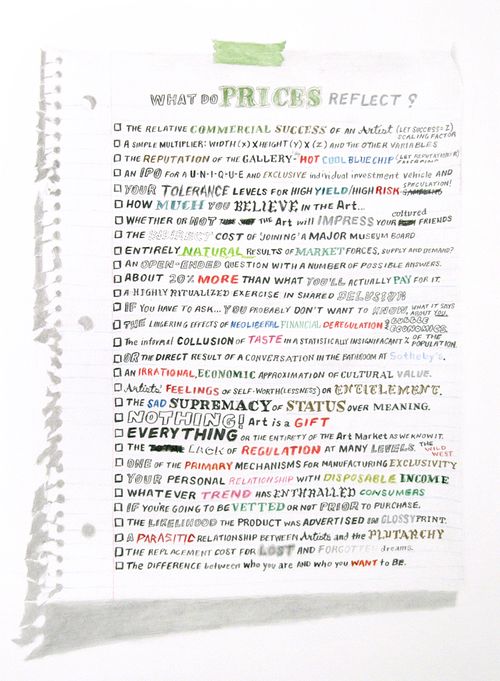
William Powhida, "What Do Prices Reflect?" Graphite, watercolor, and colored pencil on paper, 2011. Courtesy of Postmasters Gallery.
